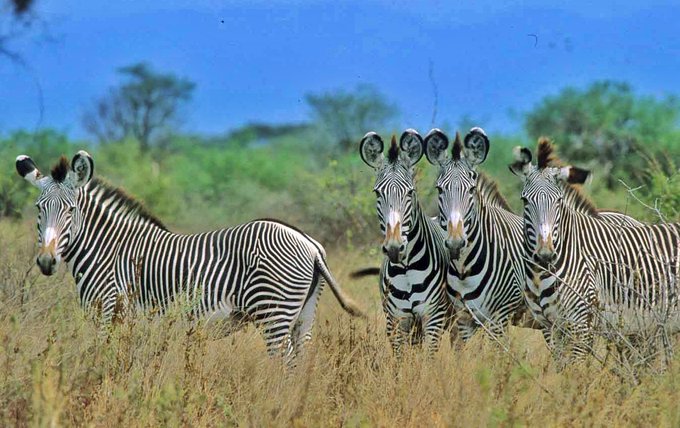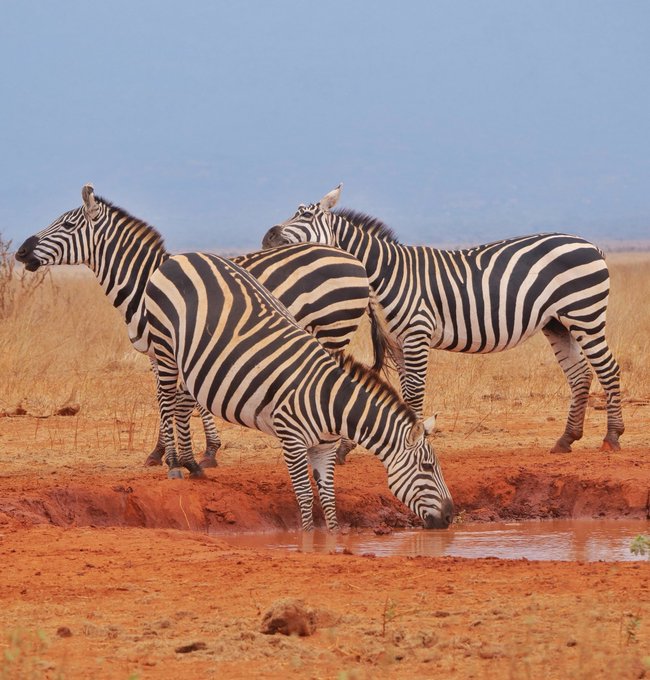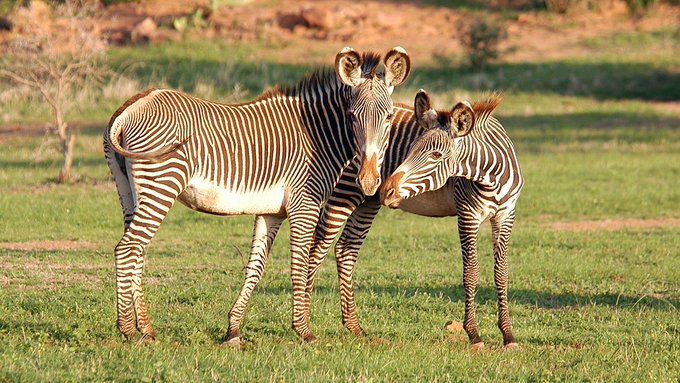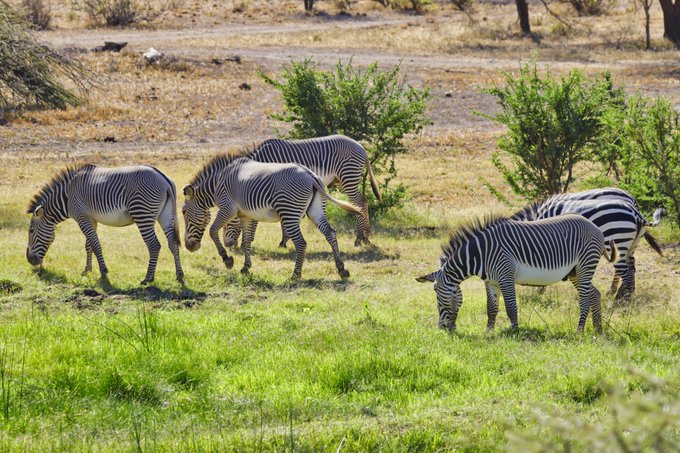NAIROBI, Kenya – A dazzle is a collection of zebras! Another name for it is a herd or zeal. When they are together, their eye-catching stripes function like magic. The Grevy’s zebra and the common zebra are two animals that we are glad to have in Kenya.
Grevy’s zebras can be identified from common zebras by their greater size, broader ears, white bellies, and thinner stripes. They originated earlier than other zebra species after asses and are the largest of the equine species.
Unlike Grevy’s zebras, which are primarily found in dry areas of northern Kenya, common zebras live in a wider variety of habitats.
Y News looks at other key characteristics of these two species of zebras
What is a Grevy’s zebra
The largest of the wild horses is the long-legged, endangered Grevy’s zebra. It can be identified by its peculiar stripes, which are just as unique as fingerprints.
Brown with reddish-brown streaks, foals’ coats eventually turn black. While the plains zebra is more directly connected to the horse, the Grevy’s are more closely related to the wild ass.
In comparison to plains zebras, grevy’s are taller, have wider ears, and have narrower stripes. Among the zebra species, they are the biggest.
Challenges
The Grevy’s survival is seriously threatened by habitat loss in an already constrained range.
In addition to cattle and animals, they must contend with other grazers for resources. Grevy’s juveniles have a poor survival rate due to overgrazing and water competition.
From an estimated 5,800 people in the 1980s, the population has decreased by 54% during the last three generations (30 years). The Red List of Threatened Species lists the Grevy’s as endangered, with a current population of roughly 2,800.
Can you tell the difference between Grevy’s Zebra and the Common Zebra?Grevy’s Zebra is found mainly in dry, arid regions of northern Kenya, while the Common Zebra Inhabits a broader range of habitats, including savannas, grasslands, and woodlands across Eastern Africa.
The main factor contributing to Grevy’s zebra loss in Ethiopia is hunting.
Although they are mostly targeted for their beautiful skins, they are also occasionally slaughtered for food and, in some areas, for therapeutic purposes. Grevy’s are threatened not just by illegal hunting but also by disease outbreaks, habitat degradation, drought, and population fragmentation.
Solutions
In Buffalo Spring National Reserve, the African Wildlife Foundation partnered with the Kenya Wildlife Service to collar Grevy’s. The GPS-GSM collars give scientists vital information about their whereabouts and movement habits. Scientists are better equipped to safeguard the zebras if they can comprehend their patterns.
AWF provides scouts with the necessary equipment, including cars and GPS monitoring devices, and collaborates with communities that coexist closely with animals. Consequently, AWF can guarantee improved wildlife protection in these areas and give residents more job prospects.
Social structures
Although they are loosely gregarious creatures without distinct social structures, Grevy’s zebras live in herds.
The longest enduring bonds are those between a mare and her offspring and a stallion and his territory.
Except for a territorial male’s entitlement to a mating female, dominance is essentially nonexistent within the herd.
If there are no females around, the resident male will make pleasant associations with bachelor males.
There are 2 species of Zebras in Kenya; the Common Zebra, and the Grevy’s Zebra The Kenya Common’s stripes are broad and continue down into the belly The Grevy’s are very narrow and stop on the lower flanks leaving the belly unmarked @NajivuniaUkenya @kenyadirect Photo; APlüss
After six minutes, newborn foals can stand; twenty minutes later, they can walk; and an hour later, they can run. Until they are between six and eight months old, they are reliant on their mothers for milk.
Males typically remain with their mothers for up to three years, while females typically stay for 13 to 18 months.
Mature female Grevy’s breed every two years, with peak birth periods often occurring in July and August.
Diet
Being highly mobile grazers, Grevy’s zebras can digest a wide variety of plant pieces that cattle cannot. Even though they are mobile, Grevy’s are water-dependent and will only move to grazing areas that are close to water.
Common zebra
The common zebra, often known as the plains zebra, is the most widely distributed horse in the world. Of the three zebra species, they are also the most prevalent and reliable.
Mountain zebras and Grevy’s zebras are the other two species.
Plains zebras typically have a varied stripe pattern and are smaller than the other two.
They migrate in response to the availability of water in certain areas, such as the Serengeti, while leading sedentary lives in others.
They frequently approach and settle in grasslands with dense vegetation first. The wildebeests and gazelles tend to move in slowly after trampling and shortening the grass.
Six separate subspecies
The recognisable plains zebras are incredibly diverse. Six distinct subspecies exist.
The degree of stripe coverage, body size, mane presence, and coat patterning are among the characteristics that differ among the subspecies. Least Concern is the designation given to five of the subspecies. However, the quagga, the sixth subspecies, is listed as extinct.
The Grant’s zebra is the most prevalent subspecies. Another subspecies found in Namibia and Angola is Chapman’s zebra. This subspecies’ legs are completely devoid of stripes.
Common distribution range
In game reserves, plains zebras are still widespread. South Africa’s Kruger National Park, Namibia’s Etosha National Park, Zimbabwe’s Hwange National Park, Kenya’s Tsavo and Masai Mara, and Tanzania’s Serengeti National Park are all home to plains zebras.
Did you know? 🦓🦓🦓A group of zebras is called a dazzle! It is also known as a herd or a zeal. Their striking stripes work like magic—when they are in a group, their patterns help confuse predators, making it hard to pick out any one zebra.In Kenya, we’re lucky to have two
Throughout its range, many of them reside in protected areas. The plains zebra is quite hardy. Even where they are not protected, they seem to be thriving well. Compared to others, its endangerment situation is not as concerning. In Lesotho, Burundi, and perhaps Angola as well, they are regionally extinct.
Feed by grazing
Zebras of the plains are herbivores. Grazing is how the ostentatious Plains zebra gets its nourishment.
They only consume particular kinds of grass. Because of their hindgut digestive mechanism, they may live off of coarse foliage that has minimal nutritional value.
It is ecologically beneficial for other grazers to have access to sensitive growth when such harder grass growth is removed.
A zebra’s back teeth keep growing throughout its life because it grinds its meal constantly.
Function for stripes
The broad black markings on the Plains zebra’s body flow horizontally towards the back and are vertical on the body.
However, there is variation in the horizontal streaks. Some populations have subtle brown shadow streaks between the black and white stripes.
They have underbelly bars as well. Despite having similar stripe patterns, no two Plains zebras are alike.
Marsabit welcomed us again! A great county! A beautiful county that is landscape infested!This is a place every wanderlust should visit!@MarsabitGov #safirinasiexperience #Safirinasi #Tembeakenya
The purpose of zebra stripes has been the subject of several theories. However, the most likely explanation is that they promote grooming behaviour and group cohesion.
Recently, a team of biologists, field researchers, and scientists from the University of Calgary and the University of California, Davis, tested the long-held belief that they act as a camouflage mechanism to confuse predators. They couldn’t find any proof of that.
Causes for concern
The plains zebra is not an endangered or threatened species. With the most stable population, the Red List categorises it as a species of least concern or near threatened.
They are rather common. They most likely number more than 750,000. The Serengeti-Mara Plains alone is home to an estimated 150,000 Plains zebras. However, they are much less common now than they were in the past.
The plains zebra population in Tanzania has decreased by 20% in just ten years. To prevent additional declines, precautions must be taken.
Plains zebras are vulnerable to poaching, habitat loss from farming and ranching, and hunting for their meat and hides, just like other wild species. Another reason to be concerned is the growth of human settlements.











